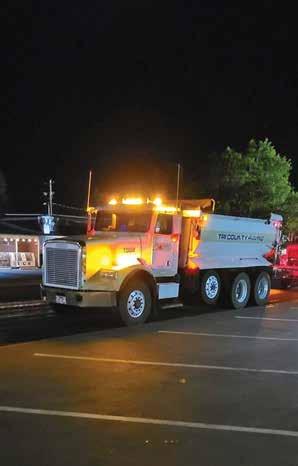
5 minute read
Bringing everything uP to standard: the City of Bend to start newPort Corridor iMProveMent ProjeCt this sPring
BRIngIng eveRyTHIng uP To sTAnDARD
the City of Bend to stArt newport Corridor improvements projeCt this spring
by shayna WiWierski
A failing storm drain system along Newport Avenue in Bend will soon be receiving improvements.
The Newport Corridor Improvements project is set to start construction in April 2021 and is part of the City’s capital improvement projects. The project will bring the City’s water, storm, sewer and roadway infrastructure up to current standards, as well as increase safety, connectivity and mobility for all users of the corridor. The project will improve the corridor which runs along Newport Avenue from College Way to 9th Street.
“It’s a pretty busy area on the west side and features a two-lane road. Underneath the corridor is a storm water trunk line and in 2017 there was a study, the South Awbrey Butte Drainage Study, which showed that the South Awbrey butte, which sits above Newport Avenue and collects a lot of storm water – or is supposed to – is having a lot of drainage issues in the area,” says Drew Wells, project engineer for the City of Bend. “Ultimately a lot of the storm water in the basin area gets sent to this trunk line, and because the majority of the trunk line, which is typically a 24- to 30-inch corrugated steel pipe, is at or near failure, it’s listed as the number-one priority for replacement in the study. The majority of that trunk line is at a Level 5 on the Pipeline Assessment Condition Program (PACP) Rating System. Ultimately, it’s failing and it’s on a busy street.”

Since the street and the utilities below are fairly old, the project will include tearing up the road and replacing the storm line and infrastructure so they can address the other aging, deficient utilities in there. Wells says that this is a synergy project, meaning that they will fix and replace multiple issues at once, such as the water and sewer, update the transportation issues, and bring the sidewalks up to city standards. The idea is that they will fix everything now so that they don’t have to go back for any major construction work in the near future.
The project is being done as a Construction Manager/General Contractor (CM/GC) project, which is a type of procurement method which allows for more upfront collaboration since the owner engages with the construction manager during the design process to provide construction input. During the design phase, the construction manager provides input regarding pricing, scheduling, phasing and other information that helps the owner design a more efficient project. GC method since the area is heavily used and important to the City. There are a lot of big stakeholders in the area, including businesses and residents, and with that method they are able to work with the constructor to determine their phasing and traffic control, detours, closures, etc. ahead of the project starting instead of guessing what those things will be during design.
“That helps us drive that process a little better, but also so we have that information up front so we can provide it to the public,” says Wells. “On top of that, there are a lot of complexities, like multiple franchise utilities, communications, power, gas, all that is there on top of the utilities we are replacing, and it’s a tight corridor, most of it is a 60-foot right-of-way so it’s pretty constrained.”
Parametrix Inc. is the primary consultant for the design of the project, with Taylor Northwest LLC being the general contractors. The project is currently budgeted at $25 million for the Newport corridor, with another $9 million for the remaining South Awbrey butte improvements, which will be phased out over time. The sewer and storm water portions of the project are funded through the DEQ’s Clean Water State Revolving Fund, which is a low-interest loan program.
Once construction starts in April 2021, the current plan is to have five segments, working from east to west. The construction team will be closing each segment down to work on it and setting up detours for traffic. Instead of having large detours which push people to busy streets, they will be using local streets, but planning ahead for those to minimize the amount of impact to the area.
Liz Dolan, project manager at Taylor Northwest LLC, says that the 18-monthlong project will start at the low end down the river and then work its way up to the College Way roundabout.
Segment one will go from the river up to the 9th Street roundabout, segment two is from the roundabout to 12th Street, segment three is from 12th Street to 14th Street, segment four is 14th Street to Juniper Street, and then segment five is from Juniper Street to College Way.

The project is being done as a Construction Manager/General Contractor (CM/GC) project, which is a type of procurement method which allows for more upfront collaboration.
“Each segment varies in length a little but they are broken down based on schedule and what makes the most sense for traffic control and what makes the most sense for the staging and being able to get the work done without disturbing certain sections at a time, instead of the entire corridor,” says Dolan.
In addition to the detours, they will also be installing a dog bone between two intersections, which is an intersection control that will help slow the speed of traffic. The dog bone will consist of two roundabouts which go from 11th Street to 12th Street with a connecting median. It will allow for cars to slow down and not make any left-hand turns through the area.
Once the project is complete in late 2022, it will bring an updated reliable network of City infrastructure underground, as well as an up-to-date transportation system above ground. The City targets for this area to include continuous bike lanes, sidewalks on both sides, and a functional transportation system for vehicles. Since they aim to fix everything at once, in the future the idea is that the area will only require routine maintenance every 15 years or so.
“Our goal is to do it once and ideally not have to go back for 50-plus years because all this infrastructure has been pulled up, except for some routine maintenance. We may have to grind down two inches and repave every 15 years or so, pretty minor disruptions,” says Wells. “We are trying to make this a comfortable area, especially for businesses and for people to come down and use. We also want to increase the safety for pedestrians in this area. That’s a big factor.” l

Once construction starts in April 2021, the current plan is to have five segments, working from east to west.









